Alfa Romeo won four races during the 1951 Formula One season, earning Juan Manuel Fangio the championship, but the three victories by Ferrari signaled an end to Alfa Romeo's dominance. They withdrew from the top-class international racing but remained in the motorsport scene with customer GT, rally and saloon racing, eventually returning to a factory-supported racing program in the fall of 1964. 
Spider
Chassis #: AR11512*010*
Engine #: 11512-071
View info and history
Auction entries : 2Orazio Satta Puliga and his experimental department developed a special sports racing car identified by internal number 105.33 – or Tipo 33. The project was soon handed over to Autodelta, the Alfa Romeo competition subsidiary established by former Ferrari engineers Ludovico Chizzola and Carlo Chiti. Form in 1961 (as Auto-Delta), it officially became a department of Alfa Romeo on March 5th of 1963, becoming Autodelta SpA in 1964. This company's purpose was to re-establish Alfa Romeo's credentials at the highest level of motor racing, and their first project had been the Giulia TZ introduced in June of 1962. The TZ became the TZ2 in 1965 following upgrades, and both models earned numerous victories for Alfa Romeo. The GTA introduced later brought even more success.The Tipo 33 was built and raced in several distinct versions between 1967 and 1977, with the first examples employing a two-liter, fuel-injected V8 engine. A straight-4 engine from the Alfa Romeo TZ2 had been used but was quickly replaced by the larger V8. The 90-degree, 1995cc unit produced 230 horsepower at 8,800 RPM, was backed by a six-speed manual transmission, and placed within a tubular chassis. The inaugural racing debut of the 2000cc Tipo 33 was in March of 1967 at the Belgian hillclimbing event at Fléron, with Teodoro Zeccoli winning. It received the nickname 'periscope' because of its unique air inlet on the roof resembling a periscope. Although it proved successful at the hillclimb, its endeavors in the 1967 World Sportscar Championship season were less fruitful, with its best finish being a fifth place at the Nurburgring 1000, co-driven by Zeccoli and Roberto Bussinello.Alfa Romeo 33/2
The Alfa Romeo 33/2 was built to contest the 1968 season and was built alongside a road-going version called the Alfa Romeo 33 Stradale. The 'Stradale' was the fastest commercially available car for the standing kilometer at the time and just 18 examples were built between 1967 and 1969. Its body was built by Franco Scaglione while Autodelta handled the mechanical aspects. The body was formed from aluminum and mounted to an aluminum tubular chassis. These hand-built vehicles had dihedral doors, also known as butterfly doors, and were the first production vehicles with this feature. Power was sourced from a 1,995cc dual overhead camshaft V8 that was closely related to the engine powering the Alfa Montreal. The unit in the Stradale had a flat-plane crankshaft, similar to the racing version, and an oversquare bore x stroke of 78mm x 52.2 mm. It had SPICA fuel injection, four ignition coils, twin spark plugs per cylinder, and dry-sump lubrication. With 10.5:1 compression, a rev-limit of 10,000 RPM, and four chain-driven camshafts operating the DOHC 2 valves per cylinder valvetrain, the engine delivered 227 horsepower at 8,800 RPM and 206 Nm of torque at 7,000 RPM in road-going guise - the competition specifications boosted output to 270 bhp (or higher). Both Stradale and the racing version used a six-speed transaxle made in-house by Alfa Romeo.
Spider
Chassis #: AR11512*010*
Engine #: 11512-071
View info and history
Auction entries : 2The suspension followed a conventional setup with lower wishbones, top links and twin trailing-arms in the back, and double wishbones at the front. Ventilated disc brakes provided the stopping power with the back being mounted in-board. During the 1968 season, the larger and more powerful engines of the Porsches consistently outclassed the rest of the field, including Alfa Romeo. The Tipo 33/2 was successful in earning several class victories during 1968, earning Alfa Romeo third in the 1968 International Championship for Makes. The Alfa Romeo 33/2 won the 2-liter class at the 24 Hours of Daytona in 1968, with drivers Udo Schutz and Nino Vaccarella. This class victory earned the car the name, 'Daytona.' Nanni Galli and Ignazio Giunti earned another class victory at the Targa Florio and second place overall, followed by teammates Lucien Bianchi and Mario Casoni. At the Nurburgring 1000 km, Galli and Giunti won their class, and the 2.5-liter version finished for the first time. Over two dozen examples of the 33/2 were built for both privateers and the factory. The 2.5-liter version was introduced mid-way through the season, with approximately 315 horsepower on tap. Since the 24 Hours of Le Mans was in September, Alfa Romeo prepared four special coupes for the race, wearing long tails to help take advantage of the long, fast straights. They used two-liter power since Le Mans still had a two-liter class. Three Works cars placed 4th, 5th, and 6th, sweeping the Prototype 2000 class podium with drivers Giunti / Galli placing 1st in class. Alfa Romeo 33/3
The Tipo 33/2 had proven capable at earning class victories, but Alfa Romeo knew that to secure an outright victory, a larger and more powerful engine was required. Thus, displacement grew to 2,998cc and horsepower to 400 bhp, putting the new Tipo 33/3 on par with the Porsche 908 and the Ferrari 312P. The heads were upgraded with four valves per cylinder for the first time, and a Lucas-sourced fuel injection system was installed. The Tipo 33/3 was more than just a new engine - it was a completely new design with a full aluminum monocoque chassis. The suspension used double wishbones, coil springs, anti-roll bar, and telescopic dampers at the front while the rear used trailing arms, reversed lower wishbones, coil springs, telescopic dampers, anti-roll bar, and top links. Ventilated disc brakes provided the stopping power and steering was handled by a rack-and-pinion system. The Alfa Romeo gearbox had five forward gears. Most of the bodywork was in coupe configuration, a 'Spider' body was built and tested.
Spider
Chassis #: AR11512*010*
Engine #: 11512-071
View info and history
Auction entries : 2Alfa Romeo signed John Surtees to its list of factory drivers for the 1969 racing season, but this was not enough to help Alfa Romeo, as it struggled with reliability issues throughout the season. Three examples were brought to the Sebring 12 Hours but they performed poorly due to mechanical issues and a lack of power. A single car was brought to Le Mans but did not take part in the race following Lucien Bianchi's death in a practice session. At the conclusion of the season, Alfa Romeo was placed seventh in the 1969 International Championship for Makes.The larger and more powerful 5.0-liter Porsche 917 and Ferrari 512 dominated the 1970 season, with the Alfa Romeo consistently outclassed. They did, however, secure a third-place overall at Sebring, and Andrea De Adamich and Henri Pescarolo won their class in the 1000km Zeltweg, finishing second overall.The 1971 season was more successful for Alfa Romeo, with Rolf Stommelen and Nanni Galli winning their class at the 1000km Buenos Aires. Another class victor and second overall were earned at Sebring. Later, De Adamich and Pescarolo won outright at the 1000km Brands Hatch, followed by a class victory at Monza and another at Spa. Vaccarella and Hezemans won outright at the Targa Florio followed by teammates De Adamich and Gijs van Lennep. Another overall victory was won by De Adamich and Ronnie Peterson at Watkins Glen, and Hezemans and Vaccarella won their class at Zeltweg. At the end of the season, Alfa Romeo placed second in the 1971 Championship.
Spider
Chassis #: AR11512*010*
Engine #: 11512-071
View info and history
Auction entries : 25 Liter Group 5 Sports Cars were banned for the 1972 season, and the 3-liter cars of Ferrari, Matra, and Alfa Romeo were now slotted in the Group 5 Sports Car class. Once again, Alfa Romeo had re-visited the drawing board and elected to make numerous changes, resulting in a brand new 33/TT/3. Little was shared with its predecessor apart from the three-liter V8 and transverse, five-speed gearbox, but this was only temporary as the new flat-12 was still under development. The tubular space frame chassis remained similar to that of the 'TT' introduced late in 1971, but with adequate space to accommodate the larger flat-12 engine. Additional bracing was added to cope with the increase in power, ventilated brakes were mounted in-board at the rear, and the suspension was independent at the front and rear. The bodywork was comprised of fiberglass and featured an integrated wing at the back. Engine development had taken longer than hoped, and the 33/TT/12 did not appear until 1973 at the Spa Francorchamps round of the World Championship. Equipped with a twelve-cylinder engine with a 180-degree cylinder angle, the all-aluminum engine had a displacement size of 2,995cc and was built for both World Sports Car competition and Formula 1. It had a Lucas fuel injection system, four overhead camshafts, four valves per cylinder, dry-sump lubrication, and produced approximately 500 horsepower @ 11,500 RPM. 
Spider
Chassis #: AR11512*010*
Engine #: 11512-071
View info and history
Auction entries : 2Although it was brought to Spa Francorchamps, it did not participate in the race, as during the practice session, it crashed after a tire failure at high speed. Two examples crashed at the Targa Florio, and the remained of the season were plagued by both accidents and reliability issues. As a result, the 33/TT/12 only managed to finish once. Alfa Romeo used the lessons learned throughout the 1973 season to prepare and improve the 33/TT/12 on the off-season in preparation for the next season. The most distinguishable change was a large air intake (similar to the one used on F1 cars) located behind the cockpit. Alfa Romeo began the 1974 World Championship season with a sweep (1st, 2nd, and 3rd) at Monza, with drivers Arturo Merzario and Mario Andretti placing first overall. Matra would go on to win the remainder of the rounds throughout the season, including the 24 Hours of LeMans. The works Autodelta team withdrew from the championship partway through the 1974 season to focus on 1975. They placed fourth overall with 65 points despite sitting out the final four races. Had they remained, they (perhaps) would have been able to best Porsche's 68 points and perhaps rival the Gulf Ford team's 81 points. On the other hand, had they not focused significant development efforts during 1974, they may not have had the success they enjoyed in 1975. 
Spider
Chassis #: AR11512*010*
Engine #: 11512-071
View info and history
Auction entries : 2The 1975 World Championship for Makes was one of total domination by Alfa Romeo who won seven out of eight races. Ferrari and Matra were no longer around, which left little competition left for Alfa Romeo, and a long list of drivers to choose from. Among the list were Arturo Merzario, Vittorio Brambilla, Jacques Laffite, Henri Pescarolo, Derek Bell and Jochen Mass. At the opening round of the 1975 season, a new, turbocharged Renault-Alpine placed first at Mugello. Alfa Romeo would win the remainder, at Dijon, Monza, Spa Francorchamps, Enna Pergusa, the Nürburgring, Zeltweg and Watkins Glen. The team did not race at the 24 Hours of LeMans, which was no longer part of the championship. Alfa Romeo 33/SC/12
Following the very successful 1975 season, Alfa Romeo's focus was redirected to Formula 1, yet continued a final evolution of the Tipo 33 known as the SC 12. Its body design was similar to the TT12 and again used a monocoque type chassis. Double wishbones, coil springs, anti-roll bars, telescopic shock absorbers, and transverse arms were used in the front and rear. The 'SC' in its name was in reference to SCatolato, a boxed chassis. The 3-liter flat-12 engine offered approximately 520 horsepower. A 2,134cc twin-turbocharged version was later tested, offering 640 horsepower. Each bank of cylinders was fed with its own turbocharger. The turbocharged version raced at the end of the 1977 season.
Spider
Chassis #: AR11512*010*
Engine #: 11512-071
View info and history
Auction entries : 2The 33SC12 had little success during the 1976 season but would reclaim the World Championship for Sports Cars title for Alfa Romeo in 1977, where it faced very little competition. During the very dominant season, it finished first in every qualifying session and race, with drivers Arturo Merzario, Jean-Pierre Jarier and Vittorio Brambilla.
by Daniel Vaughan | Oct 2021
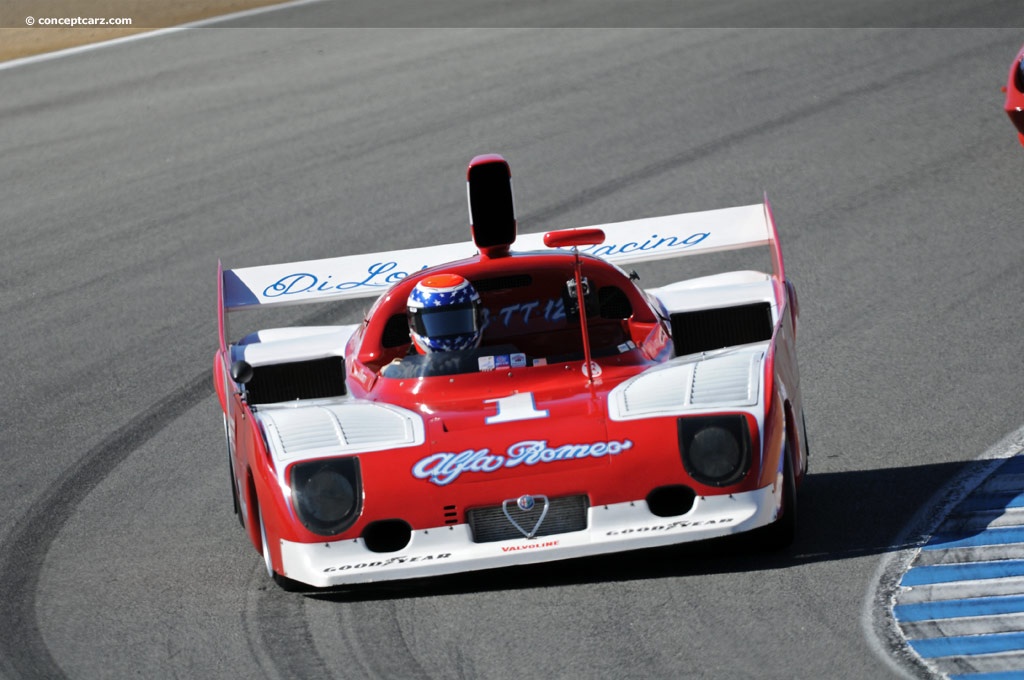
Spider
Chassis #: AR11512*010*
Engine #: 11512-071
View info and history
Auction entries : 2
The Alfa Romeo 33/2 was built to contest the 1968 season and was built alongside a road-going version called the Alfa Romeo 33 Stradale. The 'Stradale' was the fastest commercially available car for the standing kilometer at the time and just 18 examples were built between 1967 and 1969. Its body was built by Franco Scaglione while Autodelta handled the mechanical aspects. The body was formed from aluminum and mounted to an aluminum tubular chassis. These hand-built vehicles had dihedral doors, also known as butterfly doors, and were the first production vehicles with this feature. Power was sourced from a 1,995cc dual overhead camshaft V8 that was closely related to the engine powering the Alfa Montreal. The unit in the Stradale had a flat-plane crankshaft, similar to the racing version, and an oversquare bore x stroke of 78mm x 52.2 mm. It had SPICA fuel injection, four ignition coils, twin spark plugs per cylinder, and dry-sump lubrication. With 10.5:1 compression, a rev-limit of 10,000 RPM, and four chain-driven camshafts operating the DOHC 2 valves per cylinder valvetrain, the engine delivered 227 horsepower at 8,800 RPM and 206 Nm of torque at 7,000 RPM in road-going guise - the competition specifications boosted output to 270 bhp (or higher). Both Stradale and the racing version used a six-speed transaxle made in-house by Alfa Romeo.
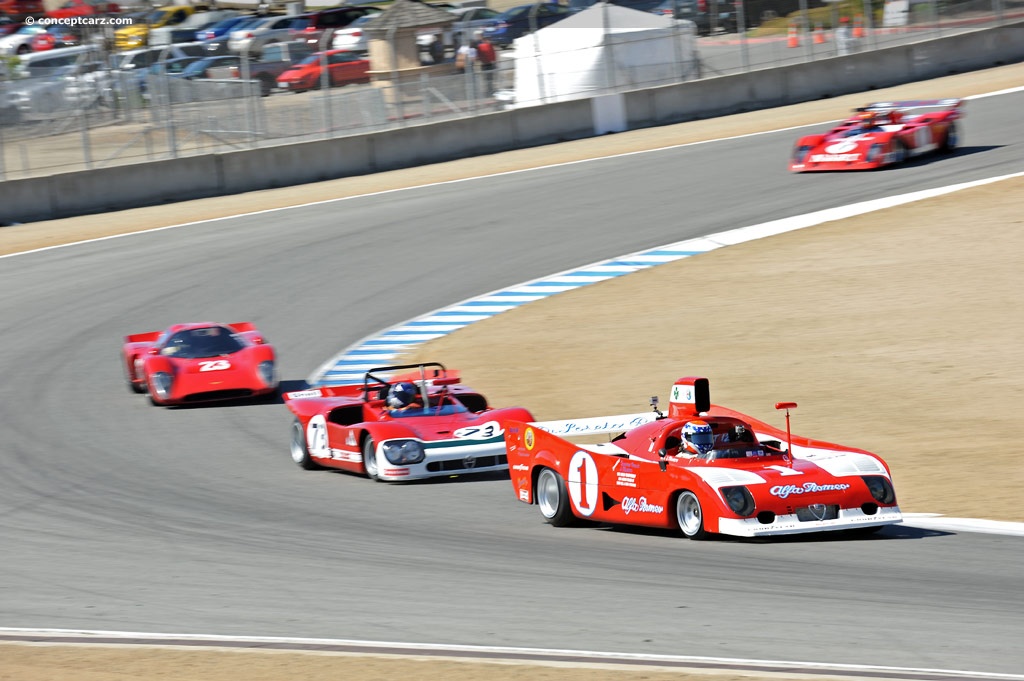
Spider
Chassis #: AR11512*010*
Engine #: 11512-071
View info and history
Auction entries : 2
The Tipo 33/2 had proven capable at earning class victories, but Alfa Romeo knew that to secure an outright victory, a larger and more powerful engine was required. Thus, displacement grew to 2,998cc and horsepower to 400 bhp, putting the new Tipo 33/3 on par with the Porsche 908 and the Ferrari 312P. The heads were upgraded with four valves per cylinder for the first time, and a Lucas-sourced fuel injection system was installed. The Tipo 33/3 was more than just a new engine - it was a completely new design with a full aluminum monocoque chassis. The suspension used double wishbones, coil springs, anti-roll bar, and telescopic dampers at the front while the rear used trailing arms, reversed lower wishbones, coil springs, telescopic dampers, anti-roll bar, and top links. Ventilated disc brakes provided the stopping power and steering was handled by a rack-and-pinion system. The Alfa Romeo gearbox had five forward gears. Most of the bodywork was in coupe configuration, a 'Spider' body was built and tested.
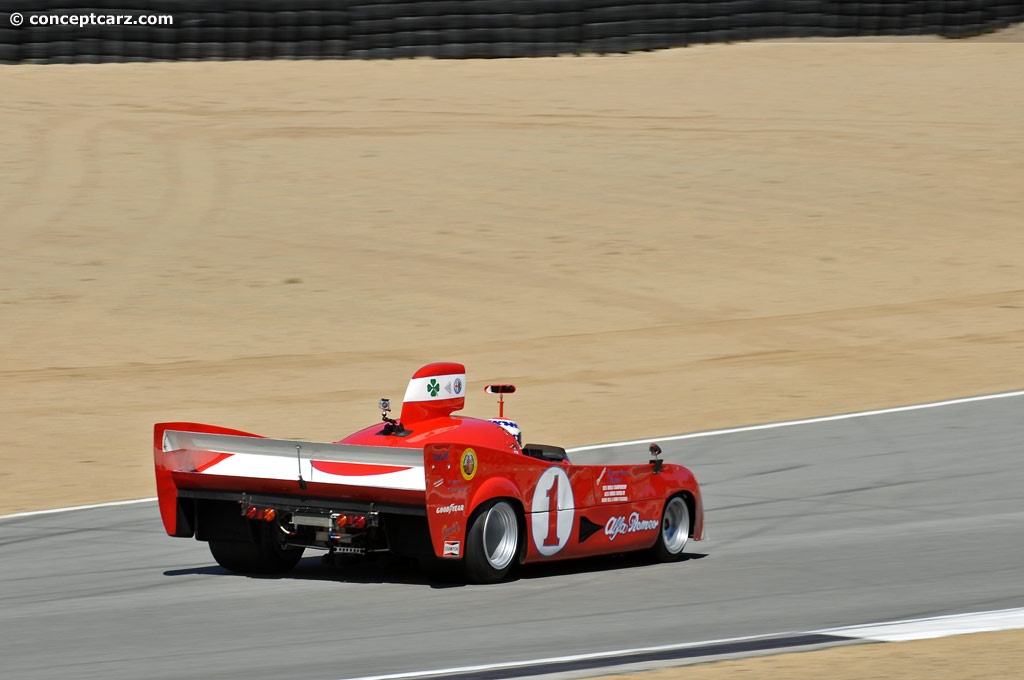
Spider
Chassis #: AR11512*010*
Engine #: 11512-071
View info and history
Auction entries : 2
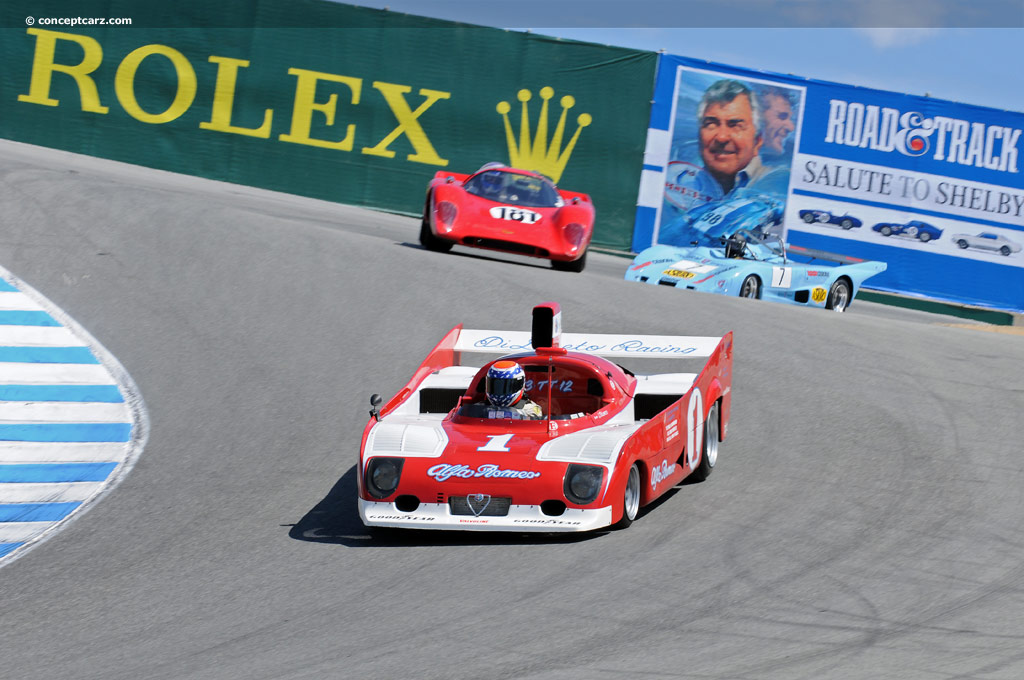
Spider
Chassis #: AR11512*010*
Engine #: 11512-071
View info and history
Auction entries : 2

Spider
Chassis #: AR11512*010*
Engine #: 11512-071
View info and history
Auction entries : 2
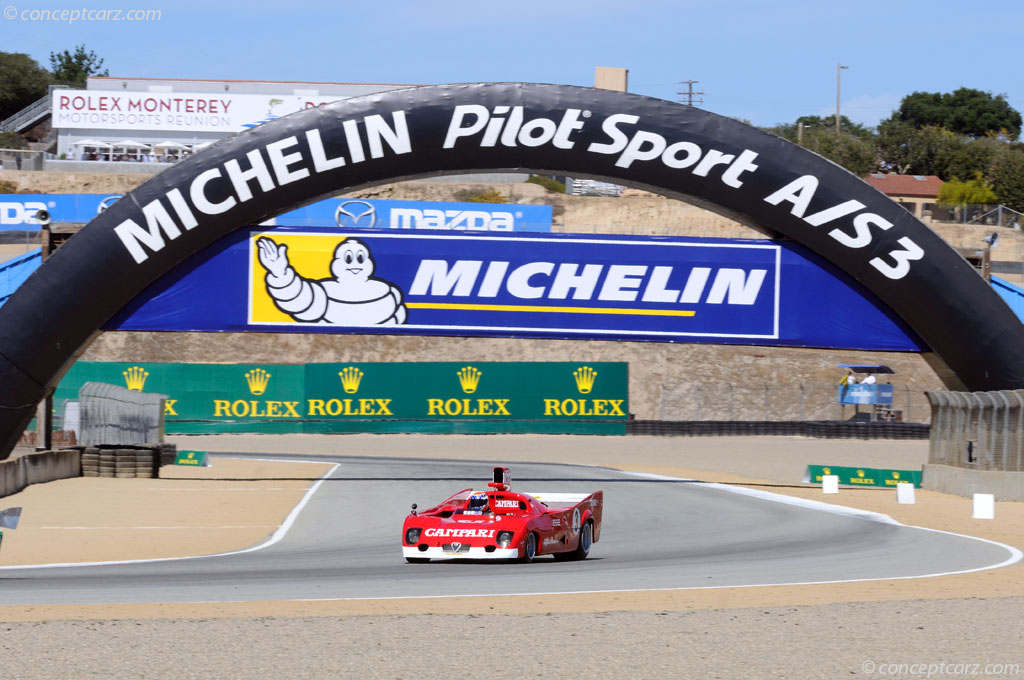
Spider
Chassis #: AR11512*010*
Engine #: 11512-071
View info and history
Auction entries : 2
Following the very successful 1975 season, Alfa Romeo's focus was redirected to Formula 1, yet continued a final evolution of the Tipo 33 known as the SC 12. Its body design was similar to the TT12 and again used a monocoque type chassis. Double wishbones, coil springs, anti-roll bars, telescopic shock absorbers, and transverse arms were used in the front and rear. The 'SC' in its name was in reference to SCatolato, a boxed chassis. The 3-liter flat-12 engine offered approximately 520 horsepower. A 2,134cc twin-turbocharged version was later tested, offering 640 horsepower. Each bank of cylinders was fed with its own turbocharger. The turbocharged version raced at the end of the 1977 season.
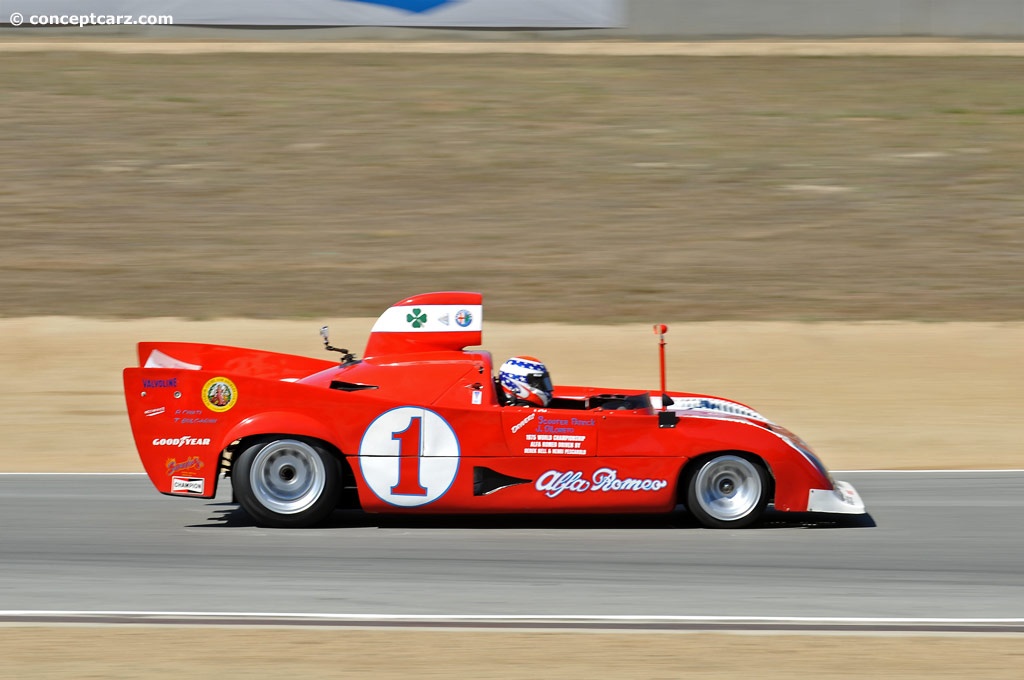
Spider
Chassis #: AR11512*010*
Engine #: 11512-071
View info and history
Auction entries : 2
by Daniel Vaughan | Oct 2021
Related Reading : Alfa Romeo Tipo 33 History
The Alfa Romeo Tipo 33 name was used from 1967 through 1977 for Alfa Romeo sports racing prototypes and even a few road-going cars. Alfa Romeos history in sports car racing goes back to pre-World War vintage. Their legacy continued in 1950 and 1951 as they won the first two Formula 1 World Championships. After this accomplishment, they retired from racing to focus on the production of road-going....
Continue Reading >>
Continue Reading >>
Similarly Sized Vehicles
from 1974
Alfa Romeo Monthly Sales Volume
March 2023
2,390
1974 Alfa Romeo 33 TT 12 Vehicle Profiles
Recent Vehicle Additions
Related Automotive News

Ferrari Museum Celebrates Scuderia Ferrari's Landmark Anniversary With The '90 Years Exhibition'
Hypercars the story of Ferraris technological evolution told through milestone cars
Maranello, xx May 2019 – One of the great iconic names in motorsport with the power to unite an entire country and millions of fans from all over the...

VIC ELFORD RECEIVES RRDC'S 2015 PHIL HILL AWARD
DAYTONA BEACH, Fla. (Jan. 22, 2015) - Vic Elford, considered one of the fastest race-car drivers of the Sixties and Seventies, was honored by the Road Racing Drivers Club with the 2015 Phil Hill Award. RRDC president Bobby Rahal made the presentation...
Luigi Musso: Talented, Tempting and Troubled
Following Alberto Ascaris back-to-back titles in 1952 and 1953 there have been no Italian Formula One World Champions. While there has been a great amount of hope throughout the years, Italians have been left without a World Champion. Perhaps, it could...

1977 24 Hours of Le Mans: Overwhelming French Defenses Were Not Enough…Again
It would be a powerful scene in the city of Reims, France on the 7th of May. General Alfred Jodl, the German Chief-of-Staff, would come to sign the unconditional surrender of Germany. The Second World War would be over and it would poignantly take place...

1969 24 Hours of Le Mans: A Traditional Statement Provides a Memorable Race
What if a statement ended up costing one of the biggest victories of ones career Would it be worth it Jacky Ickx would come close to finding out as he approached the checkered flag on the afternoon of the 15th of June in 1969.
Ford had determined...



































